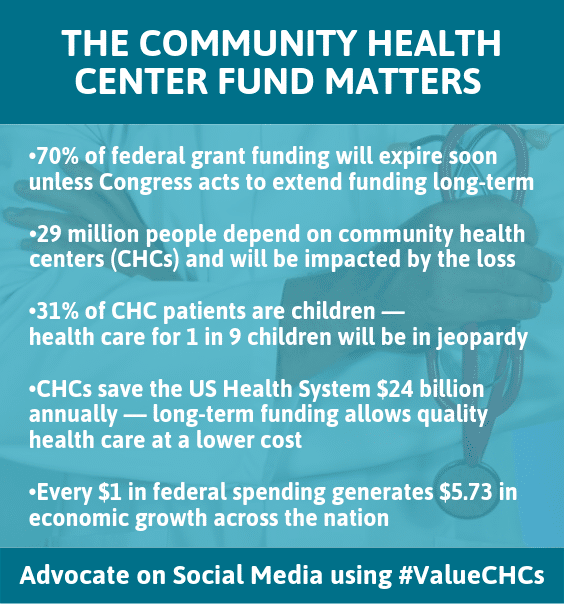Community Health Centers (CHCs) — including Federally Qualified Health Centers (FQHCs) — provide care regardless of your insurance status or ability to pay. There are nearly 1,400 health center organizations with more than 15,500 locations in urban, suburban and rural communities across the country. They can be found in all 50 states and U.S. territories. All health centers offer comprehensive primary and preventive health care. Many also offer dental, mental health and pharmacy services. -NACHC
Reasons to Celebrate
Community Health Centers have broadly improved the infrastructure of America’s health care landscape. The public health infrastructure is the foundation for undertaking the basic responsibilities of public health.¹ In other words, it provides communities, states, our nation as a whole the capacity to prevent disease, promote health, and prepare for and respond to both emergency threats and ongoing chronic health challenges. More reasons CHCs are important:
Community Health Centers
… reach more than 32 million Americans, 1 in 10.² They bring primary care to communities across the nation in a cost-effective way by providing care to many that would not otherwise be able to afford it. Of these 32+ million Americans using community health centers, about 1 in 3 are individuals living in poverty, and around 8.6 million are children.³ Providing this care helps to avoid unnecessary health expenses in time. For example, non-emergency visits to hospitals cost taxpayers billions of dollars each year, and Community Health Centers are a way to eliminate many visits that are not urgent, generating national cost savings.
… save the healthcare system $24 billion annually and spark economic activity. The average daily cost per patient served at a community health center is nearly $1 less than all other physician settings. Community Health Centers help spark economic activity and provide significant savings. Health Centers create nearly $85 billion of economic activity in their communities.²
… provide an innovative, patient-centered approach that links care teams, primary care, and behavioral health care together to deliver quality care. The gap between medical and behavioral health care systems must be bridged in order for quality care to be delivered to patients. In most circumstances, people being served by public behavioral health services need better access to primary care and vice versa. Behavioral health clinicians are a resource for assisting people with all types of chronic health conditions.⁴ Nearly 90% of Community Health Centers offer mental health services and around 66% offer substance use treatment services.⁵
… have rapidly expanded access to care and generated economic benefits for low-income communities. The United States health care spending grew 5.6 percent in 2023. Health spending accounts for 19.7 percent of the nation’s GDP.⁶ Health Centers provide an opportunity to transform the typical care system to promote quality cost savings.
… support those in need of health care and are the hope for our nation to close the health care gap. They need long-standing bipartisan support and stable funding to continue providing for citizens and addressing public health challenges. Everyone is encouraged to support local Health Centers in hopes of bridging the gap in our nation’s health care accessibility.
…report higher patient satisfaction with care. Patients of Community Health Centers report 98% satisfaction with their treatment compared to 87% of low-income patients nationally. Patient satisfaction is also high for hours of operation with 98% of patients reporting satisfaction in contrast with 37% of all low-income patients at the national level.⁷
…use telehealth to help patients. Over 99% of Community Health Centers are already using telehealth services for care. Telehealth provides cost and time-efficient high-quality care for CHC patients. With many patients using Community Health Centers located in rural areas with limited access to medical care, telehealth helps to close the care gap. 98.4% of rural CHCs are already using telehealth services to benefit patients.⁸
–
–
How to Advocate
National Health Center Week (NHCW) is an annual celebration with the goal of raising awareness and advocating for America’s Community Health Centers. It takes place in August every year and, for example, the 2019’s NHCW theme is “Rooted in Communities” to represent the positive impact and engagement CHCs have in their neighborhoods. We encourage everyone to spread the word about NHCW and its mission. Certintell supports Community Health Centers with the mission of Closing the Care Gap™.
Contacting your local congress members is a great way to share your support for Community Health Centers. Learn more: https://www.hcadvocacy.org/takeaction/
Check out the current legislation that affects CHCs: https://www.hcadvocacy.org/currentlegislation/
How Certintell Supports CHCs
Certintell supports Community Health Centers by delivering services to areas with high health disparities. We work with safety-net providers at health centers across the nation to bring patient-centered care through the use of care management services delivered through telehealth. Learn more about us:
—
Endnotes
¹ “Public Health Infrastructure | Healthy People 2020.” 8 July 2019, www.healthypeople.gov/2020/topics-objectives/topic/public-health-infrastructure.1
² “America’s Health Centers: By the numbers” NACHC. 29 Aug. 2024, https://www.nachc.org/resource/americas-health-centers-by-the-numbers/
³ “America’s health Centers: 2022 Snapshot” NACHC. 10 Aug. 2023, https://www.nachc.org/resource/americas-health-centers-2022-snapshot/
⁴ “Behavioral Health/Primary Care Integration Models, Competencies, and Infrastructure.” May 2003, https://www.integration.samhsa.gov/about-us/Mauers_Behav_Health_Models_Competencies_Infra.pdf
⁵ “Community health centers’ progress and challenges in meeting patients’ essential primary care needs” The Commonwealth Fund. 2024, www.commonwealthfund.org. https://doi.org/10.26099/wmta-a282
⁶ “NHE Fact Sheet” CMS. 10 Sep. 2024, https://www.cms.gov/data-research/statistics-trends-and-reports/national-health-expenditure-data/nhe-fact-sheet
⁷ “Community Health Center Chartbook.” 28 Jan. 2019, http://www.nachc.org/wp-content/uploads/2019/01/Community-Health-Center-Chartbook-FINAL-1.28.19.pdf
⁸ “Assessing Patient Satisfaction with Telehealth at Community Health Centers: A Policy Brief” NACHC. 28 July 2023, https://www.nachc.org/wp-content/uploads/2023/07/Assessing-Patient-Satisfaction-with-Health-Center-Telehealth-Services-A-Policy-Brief_2023.pdf

